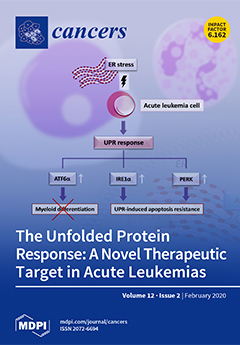Open AccessArticle
The Urinary Transcriptome as a Source of Biomarkers for Prostate Cancer
by
Carla Solé, Ibai Goicoechea, Alai Goñi, Maike Schramm, María Armesto, María Arestin, Lorea Manterola, Maitena Tellaetxe, Aitor Alberdi, Leonor Nogueira, Mathieu Roumiguie, Jose Ignacio López, Juan Pablo Sanz Jaka, Ander Urruticoechea, Itziar Vergara, Ana Loizaga-Iriarte, Miguel Unda, Arkaitz Carracedo, Bernard Malavaud and Charles H. Lawrie
Cited by 14 | Viewed by 3612
Abstract
Prostate cancer (PCa) is the second most common cancer of men and is typically slow-growing and asymptomatic. The use of blood PSA as a screening method has greatly improved PCa diagnosis, but high levels of false positives has raised much interest in alternative
[...] Read more.
Prostate cancer (PCa) is the second most common cancer of men and is typically slow-growing and asymptomatic. The use of blood PSA as a screening method has greatly improved PCa diagnosis, but high levels of false positives has raised much interest in alternative biomarkers. We used next-generation sequencing (NGS) to elucidate the urinary transcriptome of whole urine collected from high-stage and low-stage PCa patients as well as from patients with the confounding diagnosis of benign hyperplasia (BPH). We identified and validated five differentially expressed protein-coding genes (
FTH1 BRPF1,
OSBP,
PHC3, and
UACA) in an independent validation cohort of small-volume (1 mL) centrifuged urine (
n = 94) and non-centrifuged urine (
n = 84) by droplet digital (dd)PCR. These biomarkers were able to discriminate between BPH and PCa patients and healthy controls using either centrifuged or non-centrifuged whole urine samples, suggesting that the urinary transcriptome is a valuable source of non-invasive biomarkers for PCa that warrants further investigation.
Full article
►▼
Show Figures






